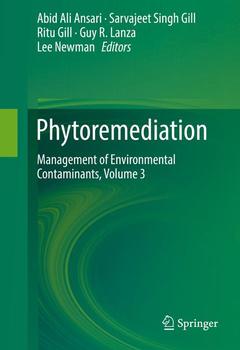Description
Phytoremediation, 1st ed. 2016
Management of Environmental Contaminants, Volume 3
Coordinators: Ansari Abid Ali, Gill Sarvajeet Singh, Gill Ritu, Lanza Guy R., Newman Lee
Language: English
Subjects for Phytoremediation:
Phytoremediation
Publication date: 10-2016
Support: Print on demand
Publication date: 10-2016
Support: Print on demand
Phytoremediation
Publication date: 06-2018
Support: Print on demand
Publication date: 06-2018
Support: Print on demand
Description
/li>Contents
/li>Biography
/li>Comment
/li>
This book details the plant-assisted remediation method, ?phytoremediation?, which involves the interaction of plant roots and associated rhizospheric microorganisms for the remediation of soil contaminated with high levels of metals, pesticides, solvents, radionuclides, explosives, crude oil, organic compounds and various other contaminants. Each chapter highlights and compares the beneficial and economical alternatives of phytoremediation to currently practiced soil removal and burial practices.
Phytoremediation of Mining Areas: An Overview of Application in Lead and Zinc Contaminated Soils.- Phytoextraction of Heavy Metals by Fast-Growing Trees: A Review.- Biological Approaches for Remediation of Metal-Contaminated Sites.- Biosorption of Heavy Metal from Aqueous Solutions.- Aquatic Macrophytes for the Removal of Heavy Metals from Coal Mining Effluent.- Heavy Metals Accumulation Ability of Wild Grass Species From Industrial Areas of Kazakhstan.- Bio-Based Methods for Waste Water Treatment: Green Sorbents.- Metal Hyper-Accumulators: Mechanisms of Hyper-Accumulation and Metal Tolerance.- Current Technical Perspective and Application of Aquatic Weeds in Phytoremediation.- Constructed Wetlands: Role in Phytoremediation of Heavy Metals.- Phytofiltration of Metal(loid)-Contaminated Water: The Potential of Native Aquatic Plants.- Phytoremediation of Heavy Metals Contaminated Soils Through Transgenic Plants.- Role of Phytochelatins in Phytoremediation of Heavy Metals Contaminated Soils.- Role of Biochar in Remediating Heavy Metals in Soil.- Heavy Metal Uptake and Tolerance Mechanisms of Serpentine Flora: Implications for Phytoremediation.- Phytoremediation: Uptake and Role of Metal Transporters in Some Members of Brassicaceae.- Phytoremediation of Shooting Range.- Potential Promising Set of Plant-Microbe Interactions for the Revegetation of Open-Pit Mining and Smelting Areas in Brazil.- Phytoremediation of Arsenic-Contaminated Soils Using Arsenic Hyperaccumulating Ferns.- Phytoremediation of Boron-Contaminated Sites.
Dr. Abid A Ansari, M.Sc., Ph.DDepartment of Biology, University of TabukTabuk, Kingdom of Saudi Arabia
Dr. Sarvajeet Singh Gill, M.Sc. (Gold medal), M.Phil., Ph.D, Dr. Ritu Gill, Ph.DStress Physiology and Molecular Biology Lab, Centre for Biotechnology,MD University, Rohtak 124 001, Haryana, India
Dr. Guy R. Lanza, Ph.D.College of Environmental Science and ForestryState University of New York (SUNY)Syracuse, NY 13210-2778
Dr. Lee Newman, Ph.DCollege of Environmental Science and ForestryState University of New York (SUNY) Syracuse, NY 13210-2778
Dr. Sarvajeet Singh Gill, M.Sc. (Gold medal), M.Phil., Ph.D, Dr. Ritu Gill, Ph.DStress Physiology and Molecular Biology Lab, Centre for Biotechnology,MD University, Rohtak 124 001, Haryana, India
Dr. Guy R. Lanza, Ph.D.College of Environmental Science and ForestryState University of New York (SUNY)Syracuse, NY 13210-2778
Dr. Lee Newman, Ph.DCollege of Environmental Science and ForestryState University of New York (SUNY) Syracuse, NY 13210-2778
Written by the world's leading authorities on phytoremediation Contains the latest case studies and applied techniques of phytoremediation Elucidates ground breaking methods for the production of plants to degrade or absorb the effects of pollutants Includes supplementary material: sn.pub/extras
© 2024 LAVOISIER S.A.S.




